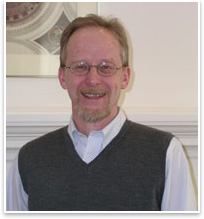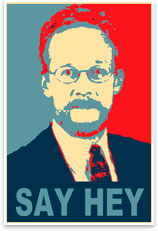 Doer’s Profile Doer’s Profile
William Babcock, Hon. AIA
by Heather Livingston
Contributing Editor
Summary: Bill Babcock is the 2009 President of the Council of Architectural Component Executives (CACE). Babcock has served the profession as executive director of AIA Wisconsin and the Wisconsin Architects Foundation since 1986, during which time he has served on numerous CACE committees.
Photos courtesy William Babcock.
Education
I received a master’s degree in economics from the University of Iowa in Iowa City, with concentrations in public finance and tax policy and urban and regional economics.
Hobbies
I like to play golf—or a reasonable facsimile—take walks in the woods with our dog, and read books, and I’m an avid college sports fan.
Current read
I try to keep a couple of books going. I just finished The Last Lecture by Randy Pausch. That gives you a little perspective on life and living and getting the most out of what you do. I like good trashy detective novels, and I’m also reading The Gate House by Nelson DeMille.
How did you end up at AIA Wisconsin?
I was working for another nonprofit organization, a good government taxpayer watchdog group. It was based here in Madison—this was in the late ‘70s—and at that time the Wisconsin Society of Architects moved their office from Milwaukee to Madison. They moved into the office next door, so I got to know the executive director and the staff and the organization over the years. Later on, when the executive director moved on to a different job, they contacted me and wanted to know if I was interested in taking on the position.
How have the needs of AIA Wisconsin members changed over time?
I was brought on board primarily for my government affairs skills and background, because the members were interested in getting more active in legislative affairs and working with the state administrative agencies to lobby for the interests of the profession. That interest has remained.
At the same time, there’s been tremendous growth and interest in continuing education programs and providing quality programs to our members at the state level. We have four all-volunteer local chapters in Wisconsin and we help those volunteer leaders at the local chapters provide programs and services to members. Throughout the state there’s been a growing interest in learning about design and learning about new project delivery methods, as well as how to manage practices better. We’ve consistently offered programs related to sustainable design and daylighting, and we work closely with the Energy Center of Wisconsin and Focus on Energy and the Wisconsin Green Building Alliance to offer a wide assortment of good programs on sustainable design and energy efficiency.
What about AIA Wisconsin’s role with the public?
As you talk to members, they often say that the public doesn’t understand what we do and doesn’t value the profession as much as they should. We address that in a couple of ways. Wisconsin started a qualifications-based selection program. Since 1986 we’ve worked with public owners, helping them set up a QBS process for selecting their architects and consulting engineers. That’s done a lot to educate city councils, county boards, school district boards, and other public citizens that come from all walks of life and participate as leaders in their communities.
We also have a well-received design awards program that gets very good press coverage. We’ve worked closely with the media in Wisconsin to get as much exposure as possible when we celebrate design excellence and recognize our members for award-winning architecture.
A good example, too, is AIA’s 150th anniversary and the Blueprint for America project. We had three local chapters that participated in a big way and have really captured the imagination of the public and demonstrated to people in their communities what architects and architecture contribute to the quality of their life. That’s been a big plus.
What was CACE’s focus at the Grassroots Leadership and Legislative Conference?
I think you couldn’t ignore the challenging economic times that all of the members are experiencing throughout the country and how CACE executives at the state and local level are responding to that. It’s been really encouraging to look at the component executives and the volunteer leaders of state and local components around the country. They’ve been really stepping up to the plate and coming up with some tremendously creative ideas to provide important services to members during these challenging times. We’ve gone from providing nuts and bolts continuing education programs to helping people who have lost their jobs, providing resources to help manage firms more effectively in tough times, and providing tools, resources, networking opportunities, and educational opportunities for members looking for work. The ballgame has changed dramatically, and I’ve been impressed with the sharing that’s going on and the creativity. I’ve certainly found some great ideas and programs in components around the country that we’ve tried to replicate and implement here in Wisconsin for the benefit of our members. There’s been an openness and sharing that’s remarkable.
 The national AIA has provided some tremendous resources on their Web site: the Navigating the Economy site for firms as well as a survival guide for components that provides a place where we can post our ideas and programs and pick up good ideas from others that we can try to implement in our own local AIA chapters. The national AIA has provided some tremendous resources on their Web site: the Navigating the Economy site for firms as well as a survival guide for components that provides a place where we can post our ideas and programs and pick up good ideas from others that we can try to implement in our own local AIA chapters.
We’ve also been working closely with national staff. We established and launched at Grassroots what we’re calling Service Networks. This is an opportunity for national staff, state and local component executives and staff, and volunteer leaders to come together and share information, learn from each other, and help define some of the services and programs that we’re going to be providing to members. We’ve established Service Networks in the six core areas of service that the AIA provides to our members: communication, membership, knowledge, advocacy, governance, and operations. We’ve undergone a multi-year effort to identify, address, and develop recommendations for component performance criteria and resource development. If you’re an AIA member located anywhere in the country, you have an expectation that you’re going to receive a certain level of service wherever you are. Of course, we’re all going to try to exceed that level, but every member should expect something from their state and local components. By working together and collaborating, we can share information, ideas, and best practices–and provide better programs to our members.
We plan to roll out in the spring a new association management system to improve our program membership database tremendously to identify and keep track of members and provide some other tools related to member services. That will be a major improvement to the way that we communicate, promote programs, provide services, and manage the whole membership process.
 What additional services can local and state chapters provide AIA members to help them weather this economic environment? What additional services can local and state chapters provide AIA members to help them weather this economic environment?
I think in these tough times, they’re all struggling. This is a really tough time to be a principal of a firm and face some really challenging economic times. The national AIA component has done a tremendous job of providing resources on its Web site and providing Webinars and other resources to help firms navigate these difficult times.
Here at our state office in Madison, we’re establishing a lot of free programs. We’re hosting Webinars on financial planning and basic management skills and inviting people in at no cost. We’re also inviting them to come in an hour before the session to network. We have an AIA Board member in Milwaukee, Kevin Connolly, who’s taken the initiative to work with Graphisoft to offer a free three-day intensive program on ArchiCAD that’s available to licensed architects who are unemployed. For younger architectural interns and associate members, we’re going to continue to offer a free architectural registration exam prep program. The seasoned practitioners are taking this opportunity to become LEED accredited professionals and learn new skills, and for the younger professionals, we’re encouraging them to take this opportunity to study and take the various divisions of the ARE to become licensed.
Final thoughts?
I think to be an architect you have to be passionate about the profession. Architecture is an optimistic profession and that’s why I’ve enjoyed working with architects for over 20 years now. I feel blessed to have had the opportunity to do that. Some of their optimism has spilled over to me because I’m an economist. It’s a dismal science with a different outlook on life. It’s really easy to fall into a little bit of despair during these times, but I’ve been encouraged by the optimism that remains, by the members I have had the opportunity to work with, and by their outlook on life. |



